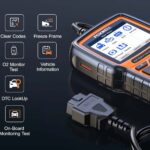Decoding car troubles can be daunting, but the On-Board Diagnostics II (OBD2) system simplifies this with a standardized set of codes. When your check engine light illuminates, it’s signaling that your vehicle’s computer has detected an issue and stored a Diagnostic Trouble Code (DTC). Understanding these codes is the first step to diagnosing and resolving automotive problems. This guide provides an overview of the List Of All Obd2 Codes and how they are categorized, helping you navigate the world of vehicle diagnostics.
Understanding the Structure of OBD2 Codes
OBD2 codes are alphanumeric, typically five characters long. The first character is always a letter, indicating the system affected:
- P (Powertrain): Relates to the engine, transmission, and related drivetrain components.
- B (Body): Concerns body-related functions like airbags, power windows, and central locking.
- C (Chassis): Deals with chassis systems such as anti-lock brakes (ABS), suspension, and steering.
- U (Network): Refers to network and communication issues within the vehicle’s computer systems.
The second character is a digit that specifies whether the code is generic or manufacturer-specific:
- 0: Generic OBD2 code (standard across all manufacturers).
- 1: Manufacturer-specific OBD2 code (unique to a particular car brand).
The third character indicates the specific subsystem within the broader system (e.g., fuel and air metering, ignition system). The last two characters are specific digits pinpointing the exact fault within that subsystem.
Generic vs. Manufacturer-Specific OBD2 Codes
Within the Powertrain (P) category, you’ll encounter different ranges that further clarify the code’s nature:
- P0xxx, P2xxx, P3xxx: These are generic OBD2 codes, meaning they are standardized across all vehicle makes and models. For instance, P0300 indicates a random/multiple cylinder misfire, regardless of whether you drive a Ford, Toyota, or BMW.
- P1xxx: These are manufacturer-specific codes. While they still relate to powertrain issues, their exact meaning can vary between car manufacturers. Therefore, when dealing with P1 codes, consulting a manufacturer-specific repair manual or database is crucial.
It’s important to note that while generic codes provide a universal starting point for diagnosis, manufacturer-specific codes often offer more detailed information about the problem.
Exploring the Categories of OBD2 Codes
OBD2 codes are broadly classified into the four categories mentioned earlier:
-
Powertrain (P Codes): By far the most common, powertrain codes cover a wide array of engine and transmission related issues. These can range from simple problems like a loose gas cap (often triggering a P0440 code related to evaporative emissions) to more complex issues like catalytic converter inefficiency or transmission malfunctions.
-
Body (B Codes): Body codes signal problems within the vehicle’s body systems. Examples include issues with power windows, lighting systems, airbags, or the anti-theft system.
-
Chassis (C Codes): Chassis codes pertain to systems that control the vehicle’s movement and stability. Common chassis codes relate to the ABS, traction control, electronic stability control, and suspension systems.
-
Network (U Codes): Network or communication codes indicate problems with the communication network that connects the various electronic control units (ECUs) within your vehicle. These codes can be more complex to diagnose as they point to communication breakdowns rather than specific component failures.
Understanding the category of your OBD2 code (P, B, C, or U) is a significant step in narrowing down the potential problem area.
In conclusion, the “list of all OBD2 codes” is extensive, but understanding their structure and categories makes diagnosing car problems more manageable. While this guide offers a foundational overview, for detailed code definitions and troubleshooting steps, it’s essential to utilize comprehensive OBD2 code resources, like the search functionality available on websites dedicated to OBD2 information. Remember, this information is for educational purposes and professional diagnosis and repair should always be sought when dealing with vehicle issues.
